Worldwide Research Trends on Wheat and Barley: A Bibliometric Comparative Analysis
Abstract
:1. Introduction
2. Methods
3. Results and Discussion
3.1. Evolution of Scientific Output and Distribution by Countries, Institutions, and Languages
3.2. Subject Categories, Sources and Types of Publications
3.3. Keywords
3.4. Patents
4. Conclusions
Author Contributions
Acknowledgments
Conflicts of Interest
References
- Curtis, B.C. Wheat in the World. Available online: http://www.fao.org/3/y4011e/y4011e04.htm (accessed on 28 March 2019).
- Peña, R.J. Wheat for Bread and Other Foods. Available online: http://www.fao.org/3/y4011e/y4011e0w.htm (accessed on 28 March 2019).
- Shewry, P.R.; Hey, S.J. The contribution of wheat to human diet and health. Food Energy Secur. 2015, 4, 178–202. [Google Scholar] [CrossRef]
- Sarwar, M.H.; Sarwar, M.F.; Sarwar, M.; Qadri, N.A.; Moghal, S. The importance of cereals (Poaceae: Gramineae) nutrition in human health: A review. J. Cereals Oilseeds 2013, 4, 32–35. [Google Scholar] [CrossRef]
- Lafiandra, D.; Riccardi, G.; Shewry, P.R. Improving cereal grain carbohydrates for diet and health. J. Cereal Sci. 2014, 59, 312–326. [Google Scholar] [CrossRef] [PubMed] [Green Version]
- Selvendran, R.R.; Stevens, B.; Du Pont, M.S. Advances in food research. In Dietary Fiber: Chemistry, Analysis, and Properties; Elsevier: Amsterdam, The Netherlands, 1988; Volume 31, pp. 117–209. [Google Scholar] [CrossRef]
- EU Register of Nutrition and Health Claims Made on Foods. Available online: http://ec.europa.eu/nuhclaims/ (accessed on 28 March 2019).
- Healthgrain Project. Healthgrain Forum. Available online: https://healthgrain.org/healthgrain-project/ (accessed on 28 March 2019).
- Orth, R.A.; Shellenberger, J.A. Origin, production, and utilization of wheat. Wheat Chem. Technol. 1988, 3, 1–14. [Google Scholar] [CrossRef]
- Hoseney, R.C.; Rogers, D.E. The formation and properties of wheat flour doughs. Crit. Rev. Food Sci. Nutr. 1990, 29, 73–93. [Google Scholar] [CrossRef] [PubMed]
- Tye-Din, J.A.; Galipeau, H.; Agardh, D. Celiac disease: A review of current concepts in pathogenesis, prevention and novel therapies. Front. Pediatr. 2018, 6, 350. [Google Scholar] [CrossRef]
- Wendorf, F.; Schild, R.; El Hadidi, N.; Close, A.E.; Kobusiewicz, M.; Wieckowska, H.; Issawi, B.; Haas, H. Use of barley in the Egyptian late paleolithic. Science 1979, 205, 1341–1347. [Google Scholar] [CrossRef]
- Purugganan, M.D.; Fuller, D.Q. The nature of selection during plant domestication. Nature 2009, 457, 843–848. [Google Scholar] [CrossRef]
- Helbaek, H.; Hole, F.; Flannery, K.V.; Neely, J.A. Plant collecting, dry-farming, and irrigation agriculture in prehistoric Deh Luran. In Prehistory and Human Ecology of the Deh Luran Plain: An Early Village Sequence from Khuzistan; Hole, F., Flannery, K.V., Neely, J.A., Eds.; Memoirs of the Museum of Anthropology of the University of Michigan: Ann Arbor, MI, USA, 1969; pp. 383–426. [Google Scholar]
- Pourkheirandish, M.; Komatsuda, T. The importance of barley genetics and domestication in a global perspective. Ann. Bot. 2007, 100, 999–1008. [Google Scholar] [CrossRef]
- International Barley Hub. Available online: http://www.barleyhub.org/ (accessed on 28 March 2019).
- FAOSTAT. Food and Agriculture Organization of the United Nations. Available online: http://www.fao.org/faostat/en/ (accessed on 28 March 2019).
- Gürel, F.; Öztürk, Z.N.; Uçarlı, C.; Rosellini, D. Barley genes as tools to confer abiotic stress tolerance in crops. Front. Plant Sci. 2016, 7, 1137. [Google Scholar] [CrossRef]
- E-malt.com. Available online: http://e-malt.com/ (accessed on 28 March 2019).
- The Maltsters Association of Great Britain. Available online: http://www.ukmalt.com/malt-facts (accessed on 28 March 2019).
- Wheat Initiative. Available online: https://www.wheatinitiative.org/ (accessed on 28 March 2019).
- United Nations UN. Department of Economic and Social Affairs. Population Division. Available online: https://www.un.org/en/development/desa/population/index.asp (accessed on 28 March 2019).
- Lal, R. Climate change and global food security. In Climate Change, Soil Carbon Dynamics, and Global Food Security; CRC Press: Boca Raton, FL, USA, 2005; pp. 132–162. [Google Scholar]
- Roberts, D.; Mattoo, A. Sustainable agriculture—Enhancing environmental benefits, food nutritional quality and building crop resilience to abiotic and biotic stresses. Agriculture 2018, 8, 8. [Google Scholar] [CrossRef]
- Sanz-Cobeña, A.; Lassaletta, L.; Aguilera, E.; Del Prado, A.; Garnier, J.; Billen, G.; Iglesias, A.; Sanchez, B.; Guardia, G.; Abalos, D. Strategies for greenhouse gas emissions mitigation in Mediterranean agriculture: A review. Agric. Ecosyst. Environ. 2017, 238, 5–24. [Google Scholar] [CrossRef]
- Calabi-Floody, M.; Medina, J.; Rumpel, C.; Condron, L.M.; Hernandez, M.; Dumont, M.; de la Luz Mora, M. Smart Fertilizers as a strategy for sustainable agriculture. In Advances in agronomy; Elsevier: London, UK, 2018; Volume 147, pp. 119–157. [Google Scholar] [CrossRef]
- Cormier, F.; Foulkes, J.; Hirel, B.; Gouache, D.; Moënne-Loccoz, Y.; Le Gouis, J. Breeding for increased nitrogen-use efficiency: A review for wheat (T. aestivum L.). Plant Breed. 2016, 135, 255–278. [Google Scholar] [CrossRef]
- Kiba, T.; Krapp, A. Plant nitrogen acquisition under low availability: Regulation of uptake and root architecture. Plant Cell Physiol. 2016, 57, 707–714. [Google Scholar] [CrossRef]
- International Barley Genome Sequencing Consortium. A physical, genetic and functional sequence assembly of the barley genome. Nature 2012, 491, 711. [Google Scholar] [CrossRef]
- International Wheat Genome Sequencing Consortium. Shifting the limits in wheat research and breeding using a fully annotated reference genome. Science 2016, 361, eaar7191. [Google Scholar] [CrossRef]
- Bockelman, H.E.; Valkoun, J.; Ullrich, S.E. Barley germplasm conservation and resources. In Barley: Improvement, Production, and Uses; Wiley-Blackwell: Oxford, UK, 2010; pp. 144–159. [Google Scholar]
- Muñoz-Amatriaín, M.; Cuesta-Marcos, A.; Endelman, J.B.; Comadran, J.; Bonman, J.M.; Bockelman, H.E.; Chao, S.; Russell, J.; Waugh, R.; Hayes, P.M. The USDA barley core collection: Genetic diversity, population structure, and potential for genome-wide association studies. PLoS ONE 2014, 9, e94688. [Google Scholar] [CrossRef]
- Pixley, K.V.; Salinas-Garcia, G.E.; Hall, A.; Kropff, M.; Ortiz, C.; Bouvet, A.S.; Singh, S. CIMMYT’s Seeds of Discovery Initiative: Harnessing biodiversity for food security and sustainable development. Indian J. Plant Genet. Resour. 2017, 231–240. [Google Scholar] [CrossRef]
- Cañas-Guerrero, I.; Mazarrón, F.R.; Pou-Merina, A.; Calleja-Perucho, C.; Díaz-Rubio, G. Bibliometric analysis of research activity in the “Agronomy” category from the Web of Science, 1997–2011. Eur. J. Agron. 2013, 50, 19–28. [Google Scholar] [CrossRef]
- Singh, V.; Perdigones, A.; Garcia, J.L.; Cañas-Guerroro, I.; Mazarrón, F.R. Analyzing worldwide research in hardware architecture, 1997–2011. Commun. ACM 2015, 58, 76–85. [Google Scholar] [CrossRef]
- Rojas-Sola, J.I.; Aguilera-García, Á.I. Global Bibliometric Analysis of the ‘Mining & Mineral Processing’Subject Category from the Web of Science (1997–2012). Miner. Process. Extr. Metall. Rev. 2015, 36, 349–369. [Google Scholar] [CrossRef]
- Montoya, F.G.; Baños, R.; Meroño, J.E.; Manzano-Agugliaro, F. The research of water use in Spain. J. Clean. Prod. 2016, 112, 4719–4732. [Google Scholar] [CrossRef]
- De la Cruz-Lovera, C.; Perea-Moreno, A.; de la Cruz-Fernández, J.; Alvarez-Bermejo, J.; Manzano-Agugliaro, F. Worldwide research on energy efficiency and sustainability in public buildings. Sustainability 2017, 9, 1294. [Google Scholar] [CrossRef]
- Salmerón-Manzano, E.; Manzano-Agugliaro, F. Worldwide scientific production indexed by Scopus on Labour Relations. Publications 2017, 5, 25. [Google Scholar] [CrossRef]
- Archambault, É.; Campbell, D.; Gingras, Y.; Larivière, V. Comparing bibliometric statistics obtained from the Web of Science and Scopus. J. Am. Soc. Inf. Sci. Technol. 2009, 60, 1320–1326. [Google Scholar] [CrossRef]
- Mongeon, P.; Paul-Hus, A. The journal coverage of Web of Science and Scopus: A comparative analysis. Scientometrics 2016, 106, 213–228. [Google Scholar] [CrossRef]
- Montoya, F.G.; Alcayde, A.; Baños, R.; Manzano-Agugliaro, F. A fast method for identifying worldwide scientific collaborations using the Scopus database. Telemat. Inform. 2018, 35, 168–185. [Google Scholar] [CrossRef]
- Montoya, F.G.; Montoya, M.G.; Gómez, J.; Manzano-Agugliaro, F.; Alameda-Hernández, E. The research on energy in Spain: A scientometric approach. Renew. Sustain. Energy Rev. 2014, 173–183. [Google Scholar] [CrossRef]
- Fischbeck, G. Contribution of barley to agriculture: A brief overview. In Barley Science: Recent Advances from Molecular Biology to Agronomy of Yield and Quality; Food Products Press: New York, NY, USA, 2002; pp. 1–29. [Google Scholar]
- Gimenez, E.; Manzano-Agugliaro, F. DNA damage repair system in plants: A worldwide research update. Genes 2017, 8, 299. [Google Scholar] [CrossRef]
- Edwards, D.; Batley, J. Plant genome sequencing: Applications for crop improvement. Plant Biotechnol. J. 2010, 8, 2–9. [Google Scholar] [CrossRef]
- Shewry, P.R. Wheat. J. Exp. Bot. 2009, 60, 1537–1553. [Google Scholar] [CrossRef] [PubMed]
- Schulte, D.; Close, T.; Graner, A.; Langridge, P.; Matsumoto, T.; Muehlbauer, G.; Sato, K.; Schulma, A.H.; Waugh, R.; Stein, N. The international barley sequencing consortium—At the threshold of efficient access to the barley genome. Plant Physiol. 2009, 142–147. [Google Scholar] [CrossRef] [PubMed]
- Hicks, K.B.; Montanti, J.; Nghiem, N.P. Use of barley grain and straw for biofuels and other industrial uses. In Barley; Elsevier: Amsterdam, The Netherlands, 2014; pp. 269–291. [Google Scholar]
- Adams, R.M.; Hurd, B.H.; Lenhart, S.; Leary, N. Effects of global climate change on agriculture: An interpretative review. Clim. Res. 1998, 11, 19–30. [Google Scholar] [CrossRef]
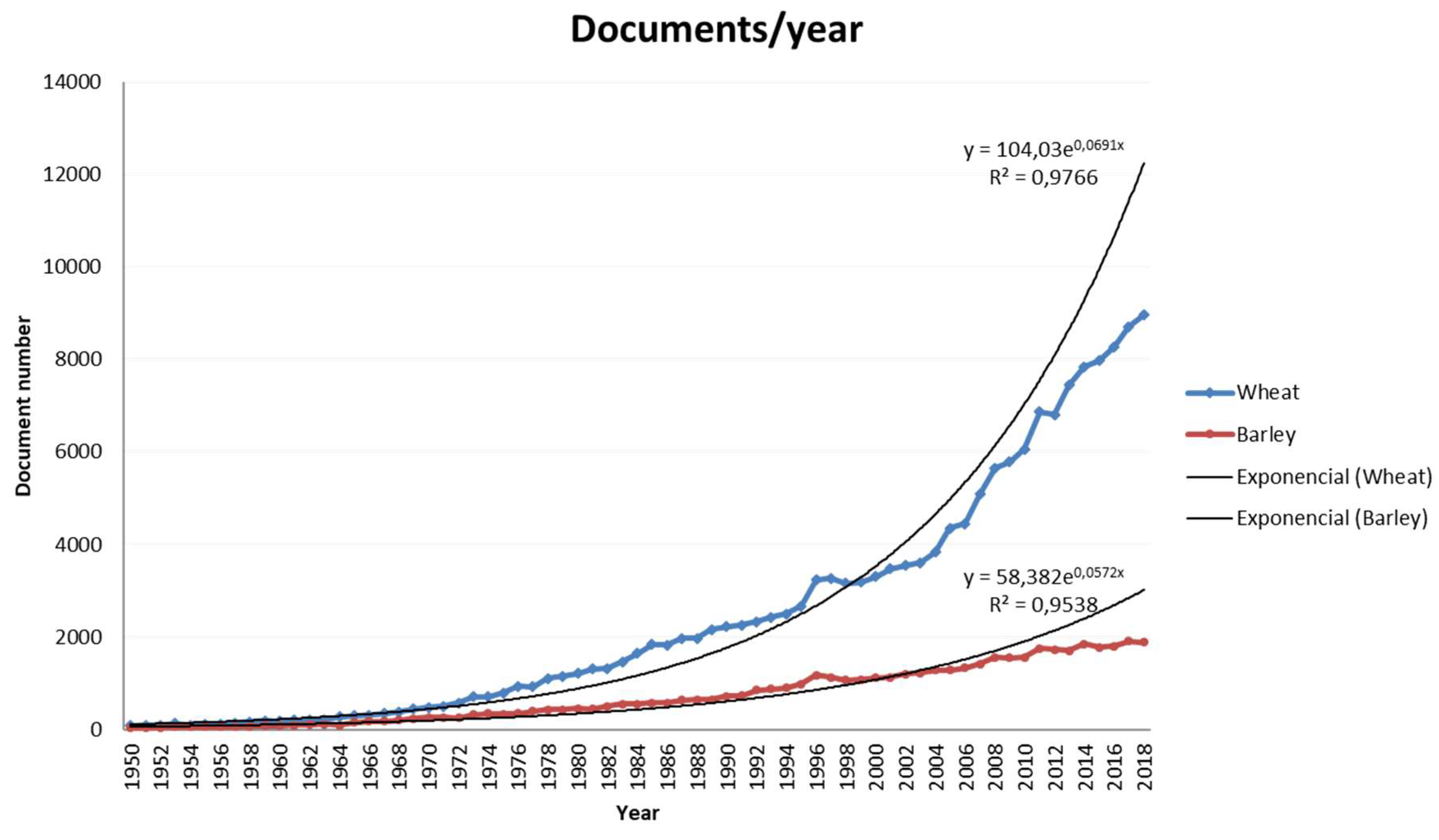

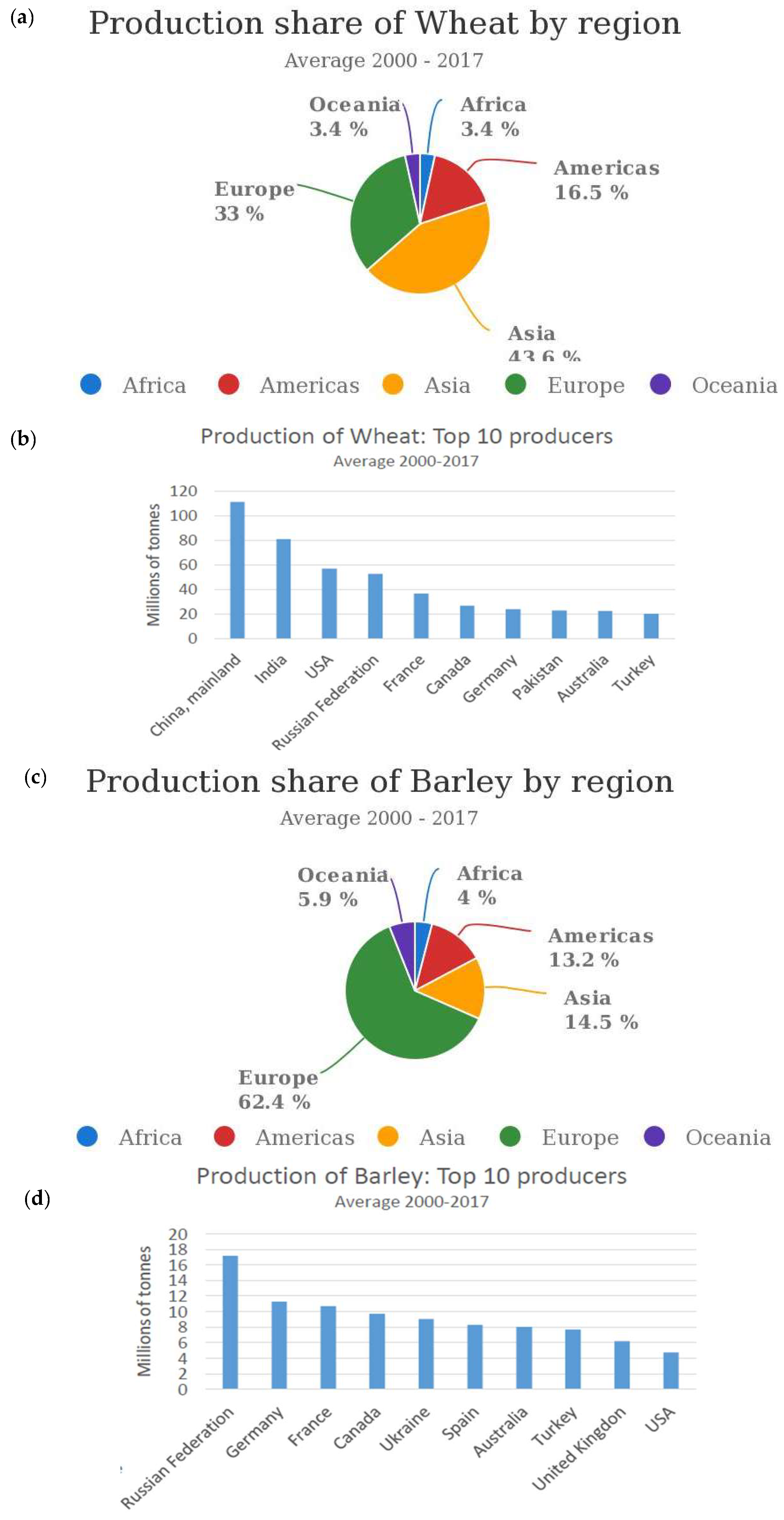
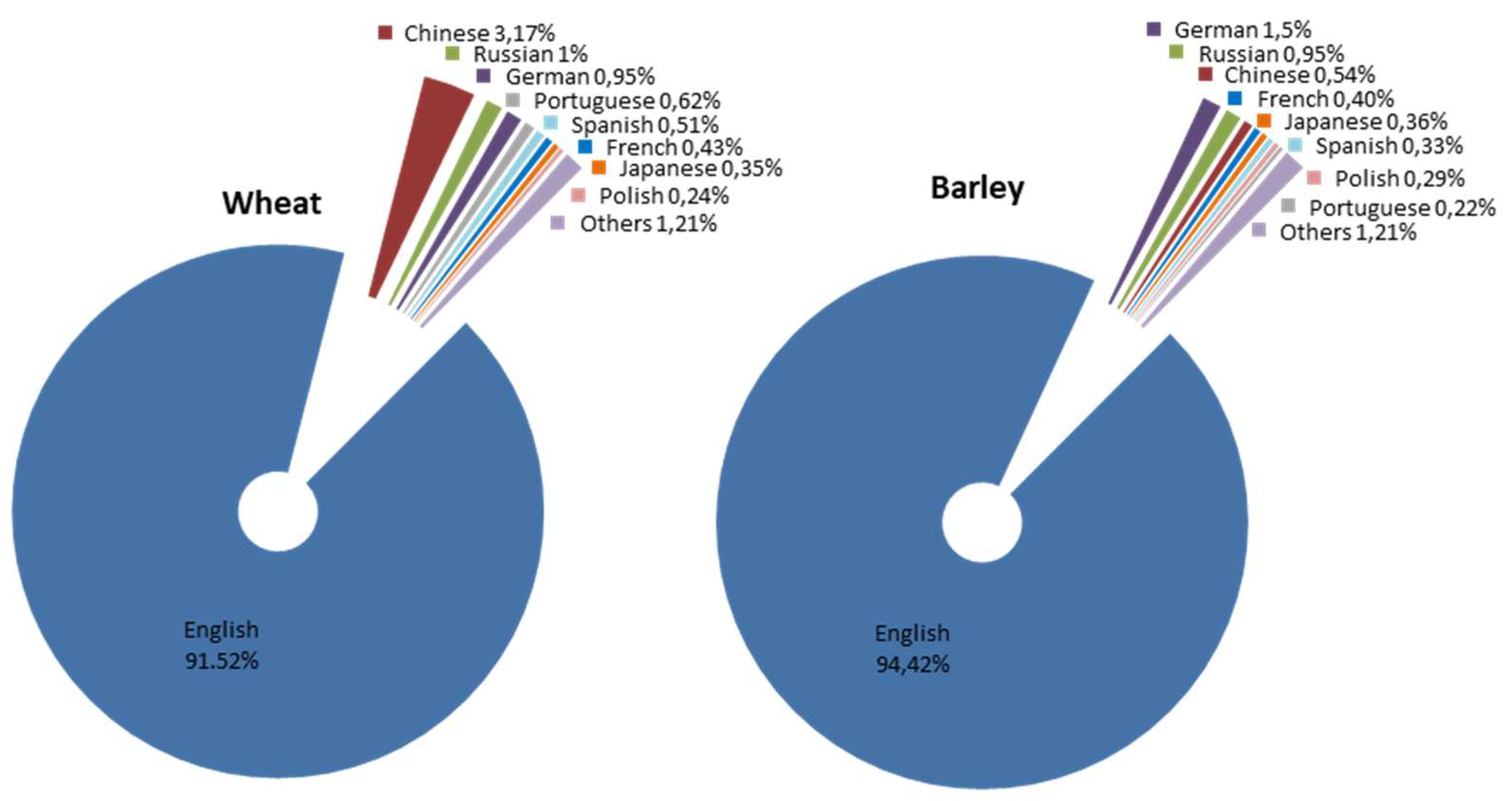
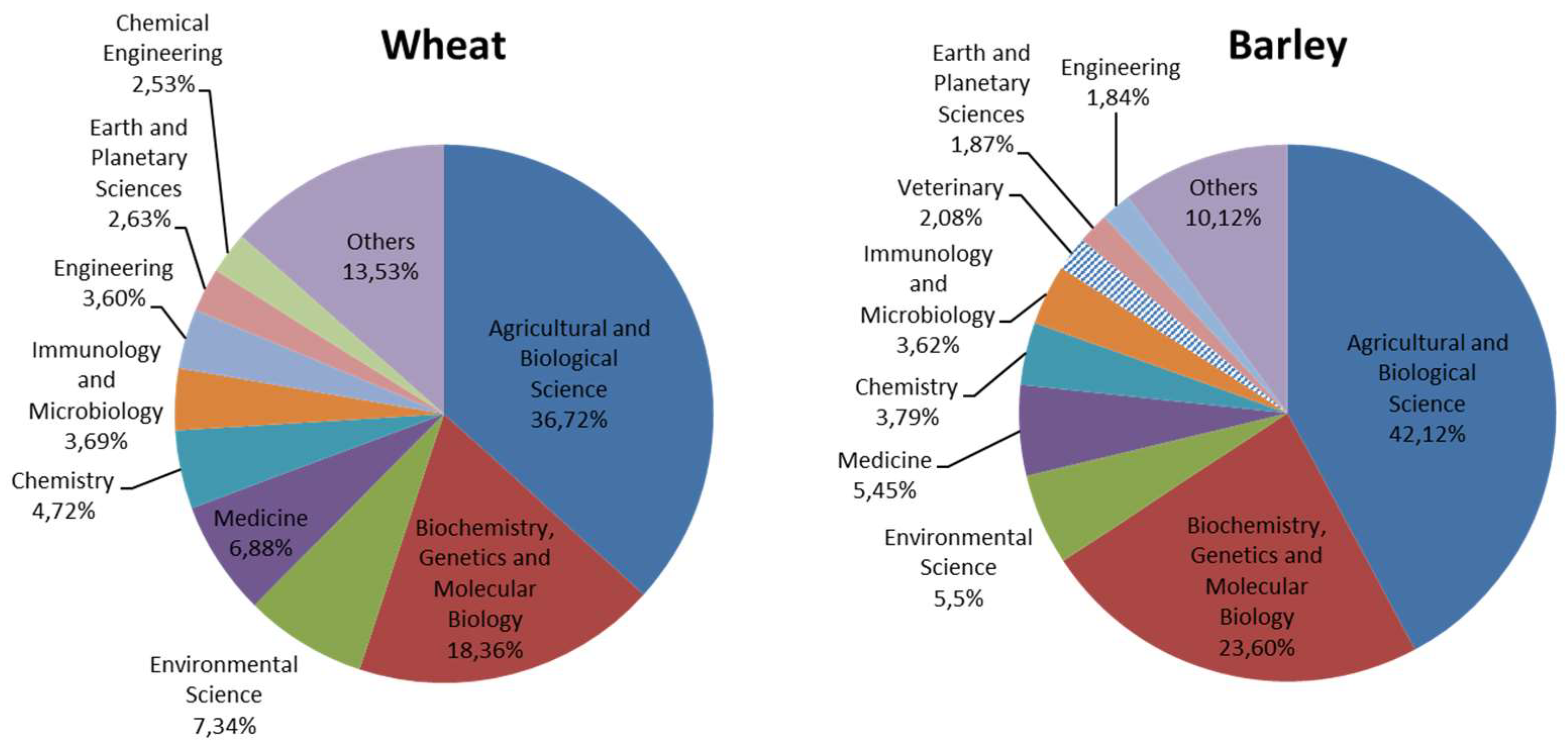
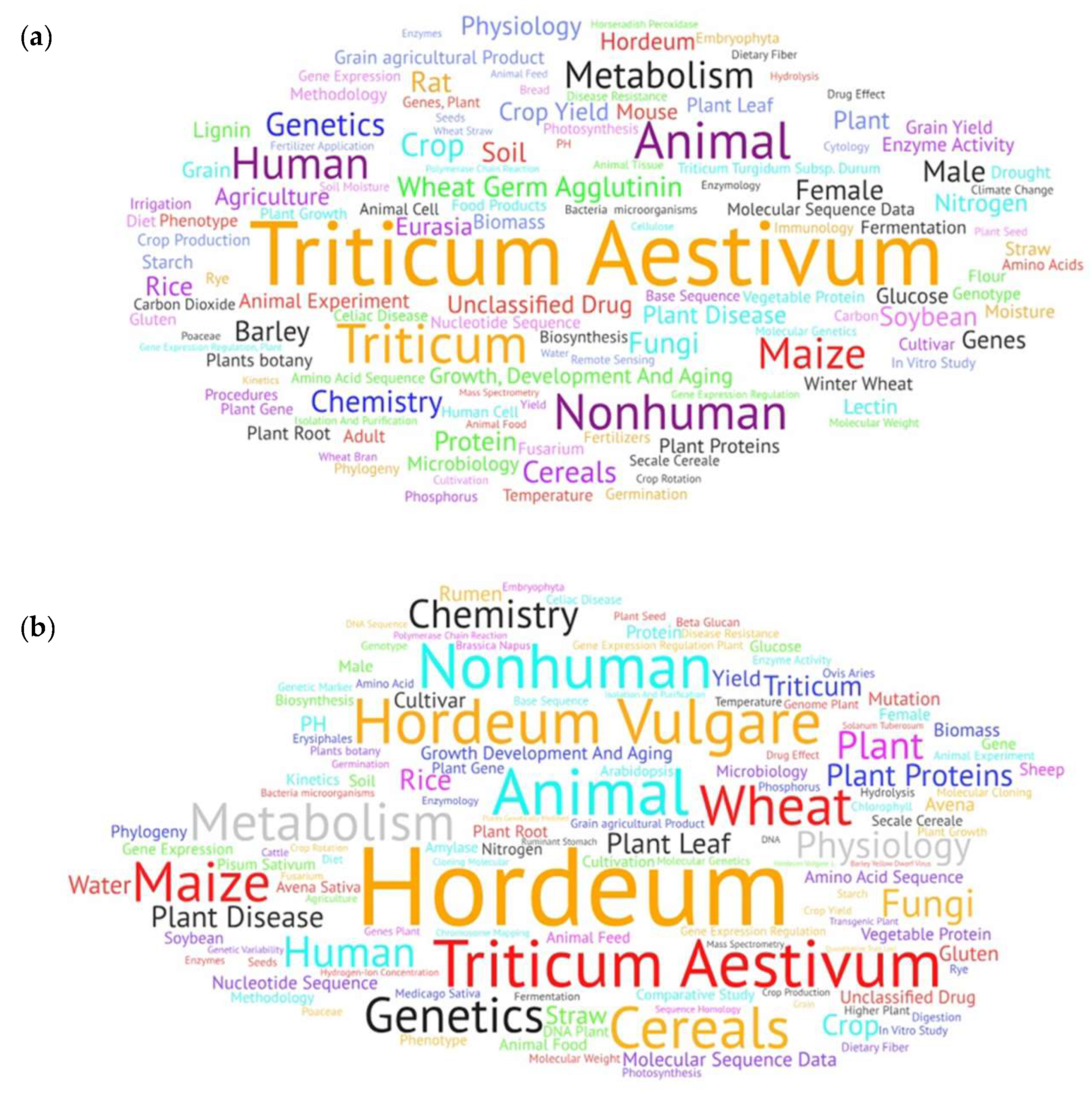
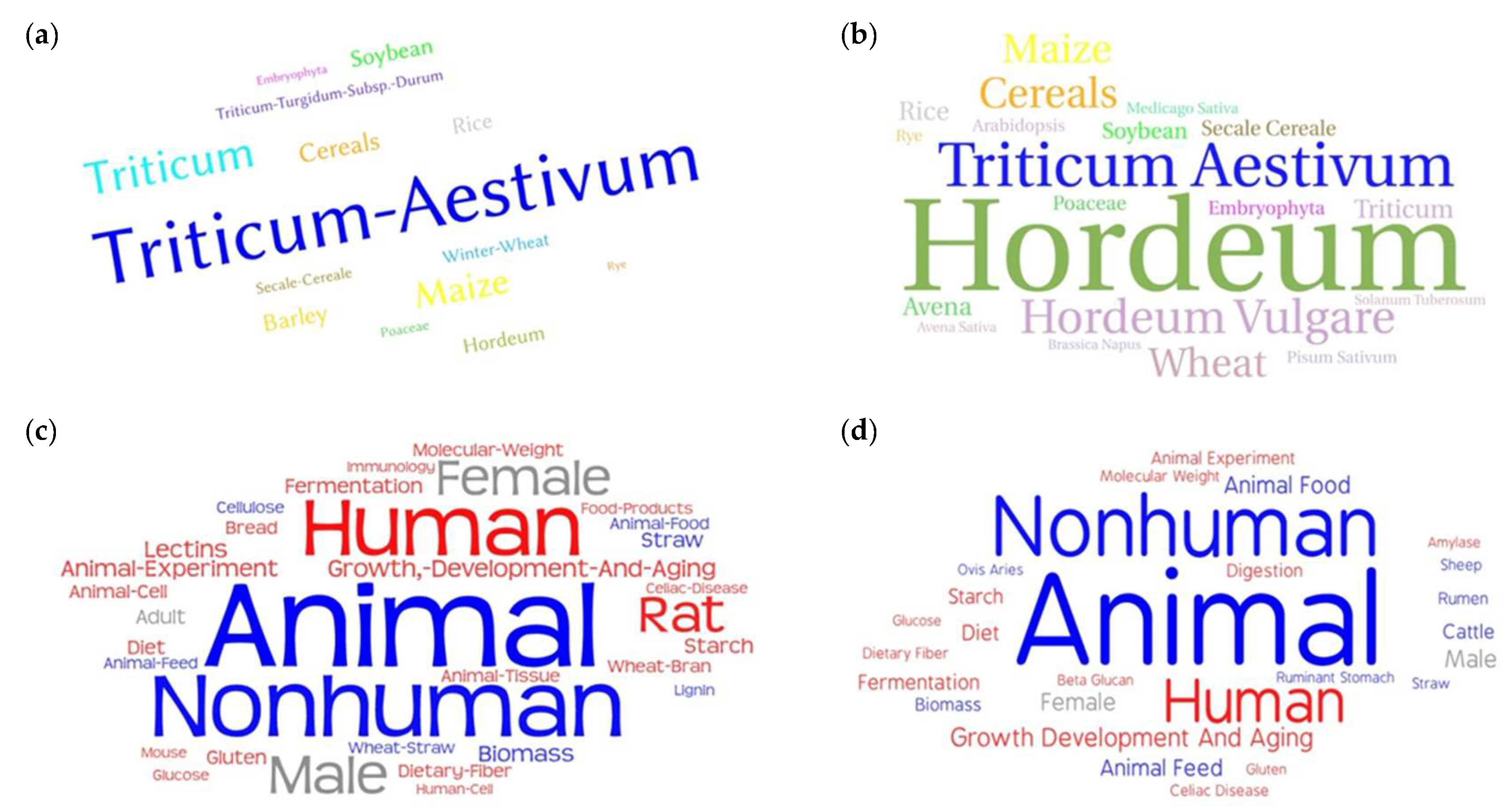
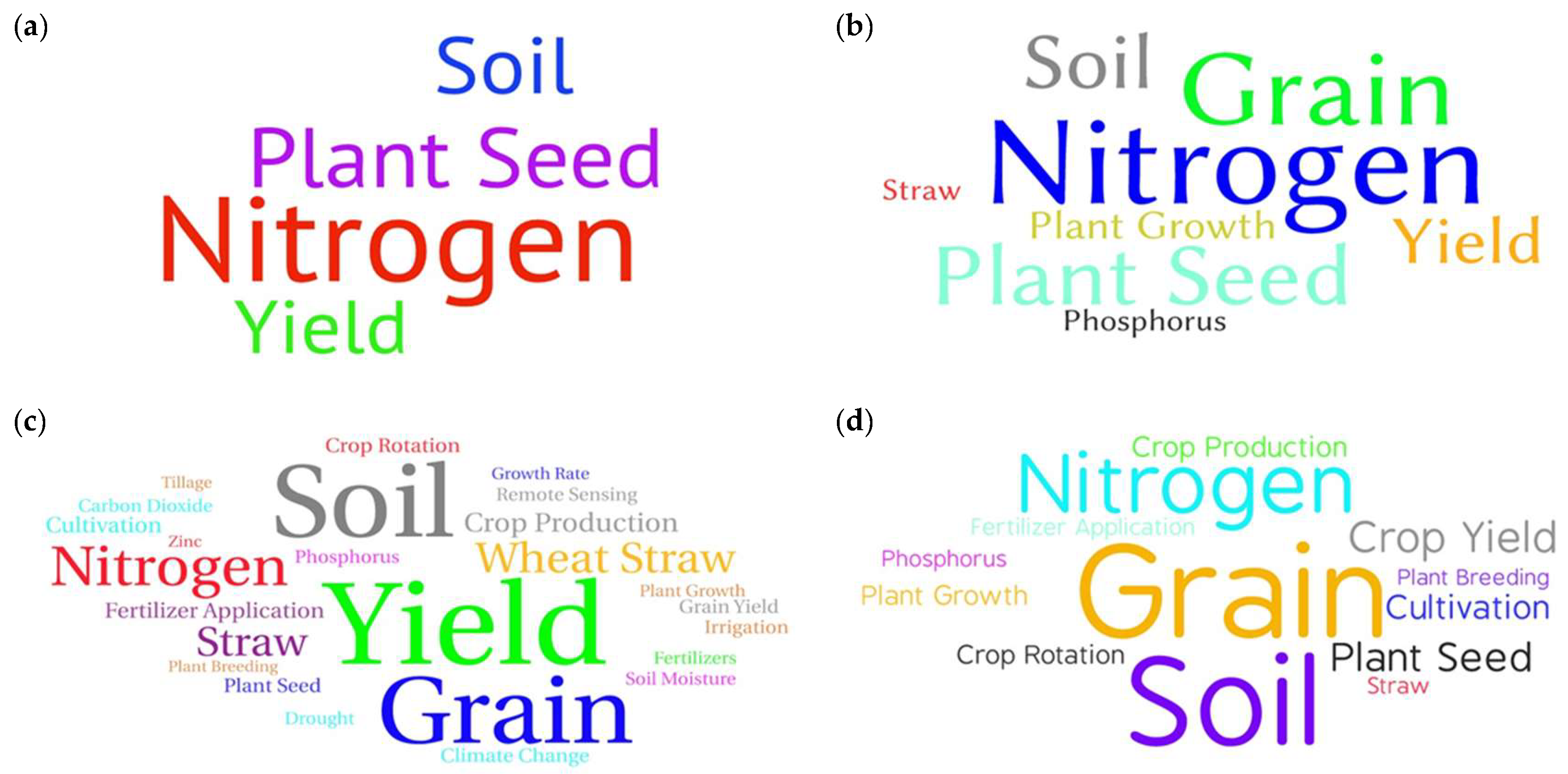


| Wheat | Barley | ||||||
|---|---|---|---|---|---|---|---|
| Position | COUNTRY | N | % | Position | COUNTRY | N | % |
| 1 | United States | 31899 | 15.40 | 1 | United States | 7646 | 12.20 |
| 2 | China | 21888 | 10.57 | 2 | United Kingdom | 6646 | 10.60 |
| 3 | India | 12845 | 6.20 | 3 | Germany | 4262 | 6.80 |
| 4 | United Kingdom | 12075 | 5.83 | 4 | Canada | 4060 | 6.48 |
| 5 | Australia | 10737 | 5.18 | 5 | Australia | 3346 | 5.34 |
| 6 | Canada | 8913 | 4.30 | 6 | Japan | 2779 | 4.43 |
| 7 | Germany | 8746 | 4.22 | 7 | China | 2373 | 3.78 |
| 8 | Japan | 7808 | 3.77 | 8 | Denmark | 2333 | 3.72 |
| 9 | France | 6398 | 3.09 | 9 | Spain | 1992 | 3.18 |
| 10 | Italy | 5292 | 2.56 | 10 | India | 1500 | 2.39 |
| 11 | Spain | 4102 | 1.98 | 11 | Sweden | 1485 | 2.37 |
| 12 | Pakistan | 3475 | 1.68 | 12 | Italy | 1341 | 2.14 |
| 13 | Iran | 3405 | 1.64 | 13 | France | 1303 | 2.08 |
| 14 | Brazil | 3142 | 1.52 | 14 | Poland | 1267 | 2.02 |
| 15 | Poland | 3135 | 1.51 | 15 | Iran | 993 | 1.58 |
| 16 | Turkey | 2927 | 1.41 | 16 | Finland | 967 | 1.54 |
| 17 | Netherlands | 2881 | 1.39 | 17 | Czech Republic | 957 | 1.53 |
| 18 | Russian Federation | 2838 | 1.37 | 18 | Netherlands | 903 | 1.44 |
| 19 | Sweden | 2576 | 1.24 | 19 | Russian Federation | 846 | 1.35 |
| 20 | Mexico | 2258 | 1.09 | 20 | Turkey | 744 | 1.19 |
| 21 | Denmark | 2258 | 1.04 | 21 | South Korea | 711 | 1.13 |
| 26 | Czech Republic | 1660 | 0.80 | 28 | Brazil | 451 | 0.72 |
| 29 | South Korea | 1421 | 0.69 | 35 | Mexico | 313 | 0.50 |
| 30 | Finland | 1303 | 0.63 | 38 | Pakistan | 259 | 0.41 |
| Wheat | Barley | ||||
|---|---|---|---|---|---|
| Affiliation | Country | N | Affiliation | Country | N |
| USDA Agricultural Research Service, Washington DC * | USA | 4798 | Agriculture et Agroalimentaire Canada * | Canada | 1695 |
| Chinese Academy of Sciences | China | 4107 | USDA Agricultural Research Service, Washington DC * | USA | 1184 |
| Agriculture et Agroalimentaire Canada * | Canada | 3355 | United States Department of Agriculture * | USA | 794 |
| United States Department of Agriculture * | USA | 3260 | Sveriges lantbruksuniversitet * | Sweden | 754 |
| INRA Institut National de La Recherche Agronomique * | France | 3152 | Rothamsted Research * | UK | 739 |
| Chinese Academy of Agricultural Sciences * | China | 2231 | Leibniz Institute of Plant Genetics and Crop Plant Research * | Germany | 705 |
| Kansas State University | USA | 2129 | The University of Adelaide | Australia | 678 |
| China Agricultural University * | China | 2088 | University of Saskatchewan | Canada | 628 |
| Northwest A&F University * | China | 1764 | The James Hutton Institute * | Scotland | 621 |
| Rothamsted Research * | UK | 1750 | University of Alberta | Canada | 602 |
| Indian Agricultural Research Institute * | India | 1708 | INRA Institut National de La Recherche Agronomique * | France | 592 |
| Wageningen University and Research Centre * | Netherlands | 1564 | Danmarks Tekniske Universitet | Denmark | 573 |
| Ministry of Agriculture of the People’s Republic of China * | China | 1497 | Wageningen University and Research Centre * | Netherlands | 531 |
| CSIRO Plant Industry * | Australia | 1367 | Carlsberg Research Center | Denmark | 527 |
| Washington State University Pullman | USA | 1334 | University of Copenhagen Faculty of Life Sciences * | Denmark | 484 |
| Ministry of Education, China | China | 1292 | Københavns Universitet | Denmark | 481 |
| The University of Adelaide | Australia | 1274 | Washington State University Pullman | USA | 465 |
| Punjab Agricultural University, India * | India | 1251 | CSIRO Plant Industry * | Australia | 458 |
| Nanjing Agricultural University * | China | 1235 | University of California, Davis | USA | 401 |
| University of Saskatchewan | Canada | 1208 | University of Manitoba | Canada | 389 |
| Wheat | Barley | ||
|---|---|---|---|
| Source Title * | N | Source Title | N |
| Theoretical And Applied Genetics (2) | 2048 | Journal Of The Institute Of Brewing | 897 |
| Journal Of Cereal Science (15) | 1762 | Theoretical And Applied Genetics | 771 |
| Journal Of Agricultural And Food Chemistry (12) | 1734 | Animal Feed Science And Technology | 669 |
| Euphytica (9) | 1715 | Plant Physiology | 577 |
| Plant And Soil (7) | 1370 | Journal Of Agricultural Science | 564 |
| Cereal Research Communications (36) | 1303 | Journal Of Experimental Botany | 561 |
| Cereal Chemistry (43) | 1273 | Plant And Soil | 540 |
| Journal Of The Science Of Food And Agriculture (11) | 1249 | Planta | 517 |
| Field Crops Research (45) | 1212 | Euphytica | 501 |
| Crop Science (25) | 1209 | Physiologia Plantarum | 476 |
| Wheat | Barley | |||
|---|---|---|---|---|
| DOCUMENT TYPE | N * | % | N | % |
| Article | 151914 | 89.73 | 45695 | 91.13 |
| Conference Paper | 7229 | 4.27 | 1387 | 2.77 |
| Review | 4388 | 2.59 | 1466 | 2.92 |
| Book Chapter | 2254 | 1.33 | 745 | 1.49 |
| Book | 190 | 0.11 | 50 | 0.10 |
| Conference Review | 174 | 0.10 | 18 | 0.04 |
| Others | 3148 | 1.86 | 779 | 1.55 |
© 2019 by the authors. Licensee MDPI, Basel, Switzerland. This article is an open access article distributed under the terms and conditions of the Creative Commons Attribution (CC BY) license (http://creativecommons.org/licenses/by/4.0/).
Share and Cite
Giraldo, P.; Benavente, E.; Manzano-Agugliaro, F.; Gimenez, E. Worldwide Research Trends on Wheat and Barley: A Bibliometric Comparative Analysis. Agronomy 2019, 9, 352. https://0-doi-org.brum.beds.ac.uk/10.3390/agronomy9070352
Giraldo P, Benavente E, Manzano-Agugliaro F, Gimenez E. Worldwide Research Trends on Wheat and Barley: A Bibliometric Comparative Analysis. Agronomy. 2019; 9(7):352. https://0-doi-org.brum.beds.ac.uk/10.3390/agronomy9070352
Chicago/Turabian StyleGiraldo, Patricia, Elena Benavente, Francisco Manzano-Agugliaro, and Estela Gimenez. 2019. "Worldwide Research Trends on Wheat and Barley: A Bibliometric Comparative Analysis" Agronomy 9, no. 7: 352. https://0-doi-org.brum.beds.ac.uk/10.3390/agronomy9070352






